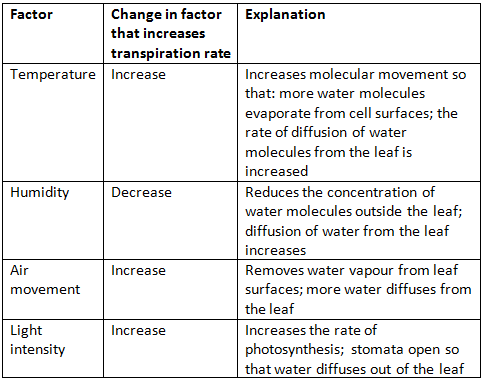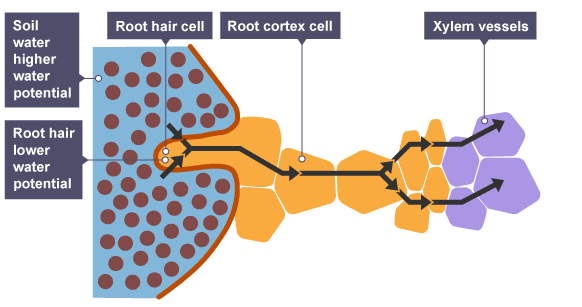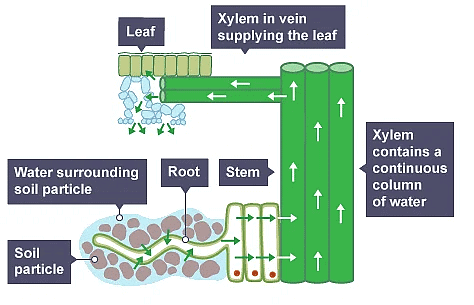Grade 10 Exam > Grade 10 Notes > Biology for Grade 10 > Transpiration
Transpiration | Biology for Grade 10 PDF Download
| Table of contents |

|
| Introduction |

|
| Water uptake and transport across the root |

|
| Factors affecting transpiration |

|
| Solved Example |

|
Introduction
- When the plant opens its stomata to let in carbon dioxide, water on the surface of the cells of the spongy mesophyll and palisade mesophyll evaporates and diffuses out of the leaf. This process is called transpiration.

- Water is drawn from the cells in the xylem to replace that which has been lost from the leaves.
- Water molecules inside the xylem cells are strongly attracted to each other. There is strong cohesion between the molecules because of hydrogen bonding. A continuous column of water is therefore pulled up the stem in the transpiration stream by evaporation from the leaves.
- As water travels through the xylem in the stem and leaf, it is being replaced by water taken up by the roots.
- Transpiration is an unavoidable consequence of photosynthesis - only five per cent of the water taken up by the plant is used for photosynthesis - but does have its purposes:
- provides the water for photosynthesis
- transports mineral ions
- cools the leaf as water evaporates
- provides water that keeps the cells turgid, which supports herbaceous plants
Water uptake and transport across the root
- Root hairs are single-celled extensions of epidermal cells in the root. They grow between soil particles and absorb water and minerals from the soil.
- Water enters the root hair cells by osmosis. This happens because soil water has a higher water potential than the cytoplasm of the root hair cell. Minerals enter by active transport.
 Soil water moves into the root hair cell by osmosis and across the root cortex to the xylem
Soil water moves into the root hair cell by osmosis and across the root cortex to the xylem - A summary of water uptake, water transport and transpiration:

Factors affecting transpiration
The rate of transpiration is affected by several factors. These include:
- temperature
- humidity
- air movement
- light intensity
The table below explains how factors increase the rate of transpiration: Plants living in different habitats have adaptations to resist extremes of these factors.
Plants living in different habitats have adaptations to resist extremes of these factors.
Solved Example
Example: What conditions will decrease the rate of transpiration?
Decrease in temperature, increase in humidity, no or reduced air movement and low light intensities.
The document Transpiration | Biology for Grade 10 is a part of the Grade 10 Course Biology for Grade 10.
All you need of Grade 10 at this link: Grade 10
|
110 videos|93 docs|9 tests
|

|
Explore Courses for Grade 10 exam
|

|
Signup for Free!
Signup to see your scores go up within 7 days! Learn & Practice with 1000+ FREE Notes, Videos & Tests.
Related Searches




















